If you enjoyed my story about Bandon Dunes, written in 1999 before the golf course opened, here’s one of the first magazine pieces written about its younger sister course, Pacific Dunes. The story appeared in Links Magazine in 2001. In more than two decades of writing about hundreds of golf courses in dozens of countries around the world, none had a stronger impact on my imagination, and inspired my writing about them, as much as Bandon Dunes and Pacific Dunes.
All Pacific Dunes photos are by Wood Sabold, official photographer of Bandon Dunes Resort. Prints are available at www.woodsabold.com.
–JCW
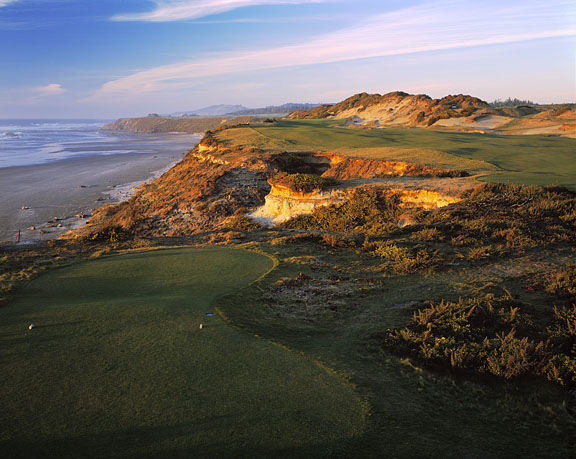
Dawn of a new age of golf. Pacific Dunes #13. Photo by Wood Sabold.
Not long ago I wrote in these pages that golf courses as good as Oregon’s Bandon Dunes come along, oh, about every hundred years or so. This July, the Bandon Dunes Resort will officially unveil its new Pacific Dunes golf course. After playing a few early rounds on Pacific Dunes recently I couldn’t help wondering: has another century flown past so soon?
You cannot talk about Bandon’s two supreme layouts without mentioning developer/owner Mike Keiser, a modest, soft-spoken visionary who amassed a fortune in the recycled greeting card business before turning his attention to golf. “I’ve been to a lot of great golf courses and I’m amazed at how few really sing,” Keiser muses. “Most of the truly wonderful courses– outside of Scotland and Ireland– are expensive or inaccessible. But the spirit of golf abides with the public golfer. I wanted to build a great golf course for the avid public golfer that would truly sing.”
In fact, the two layouts at Bandon croon, warble, yodel, and chant. They harmonize. They are more boisterous than a passel of Pavarottis belting out an aria that knocks you over backwards in your chair. They keen and wail. But Keiser didn’t exactly put this duet of courses together for a song. He spent cash, a lot of it– “A lot more than I originally ever thought I would,” he admits. “A lot of people would say, ‘What an idiot.’ No bank would have loaned even ten percent of the money for this.”
In addition to financing the two courses himself– without investors or house lots to sell– Keiser also entrusted the first layout on what may be the most beautiful curl of linksland in America to an architect who had never even designed a golf course on his own before: David MacLay Kidd. Keiser defends this eccentric choice thus: “I admire most name architects but they often superimpose their design style on your site. If you have a great site, why diminish it with a pre-formed sculpture? Finding holes as they were blown in by the wind is a far more poetic use of a great site.”
Keiser believed that an unknown architect would more likely allow the golf course to sing in its own voice rather than lip-synching for a famous designer. So for the first layout at Bandon he chose Kidd, whose pedigree included having worked for the Gleneagles Company in Scotland, and having a superintendent father who, according to Keiser, “could make talking about turf grass sound scintillating.” For Pacific Dunes, the resort’s second layout, Keiser chose Tom Doak, author of two books on course design, architect of a dozen carefully crafted venues, and widely unpopular in the business for his outspoken criticisms of other course designers.
But if Keiser rolled the dice on financing two golf courses in the absolute middle of nowhere, one designed by an architect no one had ever heard of and the other designed by an architect nobody liked, why ruin his streak of strange behavior by actually promoting the place? Bandon Dunes opened in 1999 without huge ceremony or scores of media dignitaries. Management didn’t issue press releases or advertise in glossy magazines. Keiser wanted golfers to feel as if they’d discovered Bandon Dunes on their own. Those involved with the project hoped they could put 10,000-12,000 rounds out their first year, and they even wagered on the number. Nobody guessed even close to the 35,000 rounds the course racked up once word spread about this new treasure buried in the sand along the Oregon coast. The upcoming opening of Pacific Dunes, while being pre-touted in the press and through word-of-mouth, will also occur without mountains of hype.
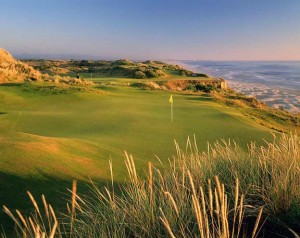
Pac Dunes #11. Photo by Wood Sabold.
Anyone who’s played golf at Bandon knows that something magical and serendipitous is afoot in this location where massive dunes and windblown pines, gorse and fescue roll down to the sea. Originally, Mike Keiser was only able to purchase 1200 acres of land– adequate for fourteen stellar golf holes and four mediocre ones. But as David Kidd fidgeted with the final routing of the first course, another 400 contiguous acres suddenly went on sale as if through sorcery. The same thing happened when Tom Doak was designing Pacific Dunes and a third parcel of land came on the market, freeing him to whip up a truly exceptional layout. If good fortune is a measure of mysterious forces working in your favor, Mike Keiser is clearly the Roy Hobbs (Robert Redford’s role in ‘The Natural’) of golf course development. He is some kind of genius. And he is another rare thing: a man with vision and the money to realize it, but also a man who cares about doing things right.
The handful of visitors who’ve glimpsed Pac Dunes (some repeat resort guests were invited to play nine holes last fall) are already whispering about the new course with a reverence usually reserved for mistresses or first cars. Status among west coast golfers is currently bestowed based upon how early you managed to play at this new and future windswept Mecca of American golf.
Although the new course resides along a stunning piece of rugged northwest coastline adjacent to the site of the original Bandon Dunes course, it is entirely different not only in architectural style but in topography. Seven holes play along the ocean, but the inland holes journey in and around humongous dunes scantily clad in gorse and beach grasses. These holes are insular– not only wind-protected but somehow hobbitlike. Dunes define this course the way they define Pete Dye’s work at Whistling Straits (in fact, Doak– along with extraordinarily talented shaper Jim Urbina– trained under Dye). But Bandon’s dunes weren’t trucked in from Idaho. They’ve lain here beneath the wind and storms and eagle turds (and bear scat!) for centuries.
If the original Bandon Dunes golf course keens the woof and whorl of a true Scottish links, if it appears glazed with single malt and orates like Sean Connery, tastes like shortbread and grilled lamb and sounds plaintive and lovely and moving as bagpipes at sunset, then the new Pacific Dunes is its Irish cousin: deep and rich as the perfect pint of Guinness, sweet as Irish cream, lively as a fiddle jig played in the back room of a warm tavern on a night when chill winds tear across the moors. It wafts flavorful hints of Ballybunion, Lahinch and Royal County Down.
Whereas Bandon Dunes greets with a wide, welcoming embrace of golf that rolls like foam-edged ocean waves, Pacific Dunes tunnels between huge sand blowouts, insular, secret, impish. Shore pines gather and scatter like elegant spectators wearing funny, windblown green hats. Leprechauns surely lurk beneath the sharp and yellow gorse mounds and whisper with reverence the words: Tom. Doak. Doak and Urbina didn’t push dirt around the site so much as they spooned it, allowing every lovely natural undulation to express itself like a gentle sonnet. Of the land Doak says simply, “You work your whole life to get a piece of property this good.”
Pac Dunes is a lot shorter than Bandon Dunes; though the par-71 layout can stretch to 6827 yards from the longest of three sets of tees, it will be set up to play around 6300 yards for most sensible golfers. The greens are smaller than those of its older neighbor, but the new course can roar like a battle hymn, especially when the wind howls along. It is nothing if not epic, and you’d be hard pressed to find its equal anywhere outside the British Isles.
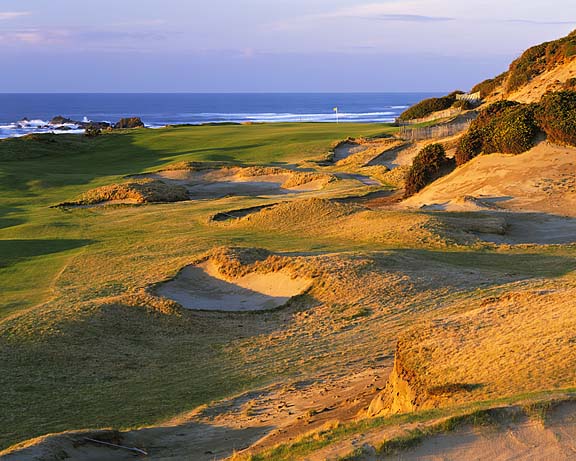
Gorgeous, sandy mayhem. Pac Dunes #13. Photo by Wood Sabold.
Pacific Dunes opens amidst pines and dramatic inland dunes and moundings. The sinuous first fairway rises in cresting green humps and then folds down toward a flattish green tucked into a dune that flows both toward it and away like a lava dome. Movements throughout the course are liquid– alternately as sweeping and forceful as whitewater and as slow as tapioca.
On the first two holes, positioning on the left side of the fairway allows for views of the greens, which should remind golfers that accurate positioning will remain important throughout their round. By the third hole, the topography spills wide to reveal a sylvan valley islanded with bunkers floating in the emerald rivers of fairway that flow alongside, away from, and down toward the sea.
Number four, the first oceanside gift, frolics for 460 yards along cliffs a hundred feet above crashing surf to a green that totters on the precipice as if one more golf ball might tumble the whole thing to the beach below. The 316-yard sixth is a “mini-me” of Pac Dunes’s character: the fairway licks between high mounds to a narrow, elevated green that drops steeply on both sides. The dune/bunker complex supporting the left side seems to whisper disparaging remarks about your backswing. To reach the garden spot, smack a slight fade over a right-side fairway bunker to a place you can’t know even has grass until you’ve played the hole before. Coming in from this position vaccinates you against the dune and affords a direct line at the green.
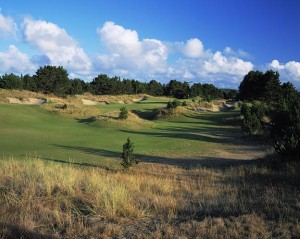
Pac Dunes #7. Photo by Wood Sabold.
Even ordinary holes such as 405-yard number seven crackle with evocative touches– here, weird natural moundings fifty yards out impart a hummocky British picnic feel. The ninth hole, one of the most Irish, calls for a drive up and over a huge ridge of dunes to a blind fairway, and presents one of the few risk/reward options on the course: how much sand to chew off. The miles-wide fairway plays to one of two alternating greens either above or below.
The back nine begins with two oceanside par threes– 205 yards threaded downhill right at the ocean, then 145 yards along seaside bluffs to a green camoflauged in dun-colored grasses. When you’ve finished with number eleven, you’ll be searching for Tom Doak to give him a hug. How could anyone not like a guy who designs golf courses this good?
Number thirteen may be Pac Dunes’ best hole. Tee off across cliffs at a humongous dune planet to a fairway that seems to share DNA with the best holes at Spanish Bay. The duneside green lies 440 treacherous yards from the tee. Tunnels and secret passageways head inland through the dunes just as you’ll do on the 345-yard risk/reward sixteenth hole, where green moguls roll like some fantastically skewed ski run. The finishing hole, which can play as long as 660 yards, is a puzzlement of angles and prodigious bunkers defending both fairway and green.
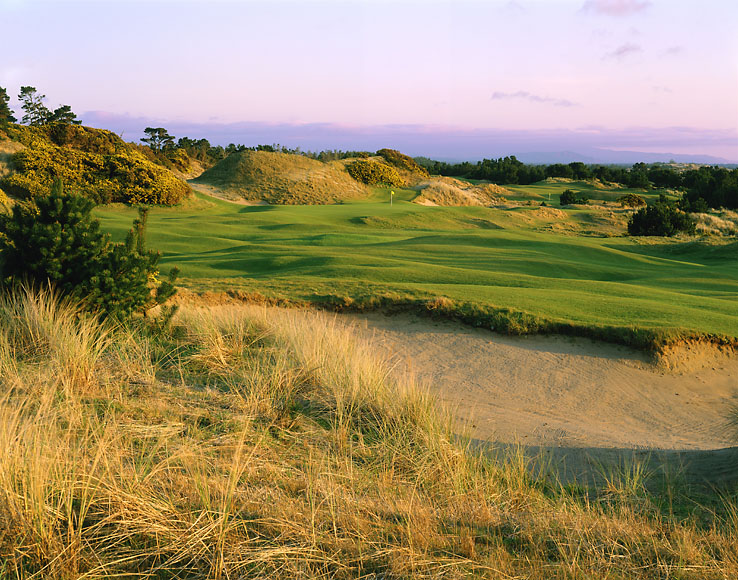
Pac Dunes #16. Photo by Wood Sabold.
Soon enough, Pacific Dunes will join hands with Bandon Dunes near the top of most experts’ lists of best courses– it is that good. And if the resort improves its hotel– which, while cute, is a bit stark and not the kind of place you or your non-golfing spouse will want to spend much time– Bandon Dunes Resort should give Pebble Beach a run for its money, especially as Bandon is half the price.
As Pac Dunes finishes greening beneath the Oregon spring in anticipation of a quiet summer debut, folks are already wondering about a rumored third course. All Mike Keiser will say is that if it does occur, he’ll hire a different architect to build a wind-protected woodlands venue that will sing a very different if equally catchy tune. We’ll await the encore with great impatience.
